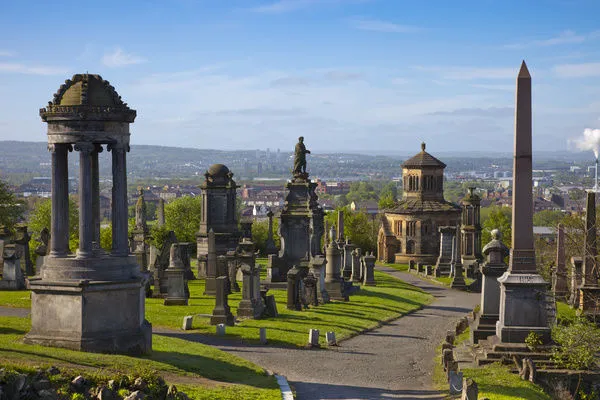The Glasgow Necropolis is a Victorian cemetery located on a prominent hill to the east of Glasgow Cathedral. As one of the most significant cemeteries in Scotland, it holds a rich history and is home to stunning architectural and sculptural monuments that reflect the grandeur and ambition of 19th-century Glasgow. Often referred to as the “City of the Dead,” the Necropolis is not just a burial ground but also a place of historical significance, artistic merit, and cultural heritage.
Historical Background
The idea of creating a large, landscaped cemetery in Glasgow emerged in the early 19th century, inspired by the famous Père Lachaise Cemetery in Paris. Before its establishment, burials in Glasgow were typically conducted in overcrowded churchyards. The demand for a more spacious and dignified resting place for the city’s elite led to the founding of the Necropolis.
The Glasgow Necropolis was officially established in 1832 by the Merchants’ House of Glasgow, a powerful and influential organization. It was developed on the site of a former Fir Park and designed in the style of a Victorian garden cemetery, intended to offer a peaceful and picturesque setting for visitors and mourners. The cemetery quickly became a prestigious burial ground, attracting many of Glasgow’s most prominent citizens, including industrialists, politicians, and artists.
Architecture and Design
The Glasgow Necropolis is known for its impressive collection of elaborate monuments, mausoleums, and gravestones, designed by some of the most skilled architects and sculptors of the time. The cemetery was planned as a multi-denominational burial ground, reflecting the religious diversity of Glasgow’s growing population.
At the highest point of the Necropolis stands a large statue of John Knox, the Scottish Reformation leader. The monument was erected in 1825, even before the Necropolis was officially established, and remains one of the most recognizable features of the site.
Many of the gravestones and tombs within the cemetery are works of art, showcasing intricate carvings and elaborate designs that highlight the wealth and social status of the deceased. Architectural styles range from Gothic and Classical to Egyptian Revival, reflecting the 19th-century fascination with different artistic influences.
Notable Burials
The Necropolis is the final resting place of over 50,000 individuals, including some of Glasgow’s most influential figures. Among the notable burials are:
- William Miller (1810–1872) – A poet best known for writing the nursery rhyme “Wee Willie Winkie.”
- Charles Tennant (1768–1838) – A chemist and industrialist who revolutionized the bleaching industry with his patented bleaching powder.
- John Henry Alexander (1812–1867) – A well-known actor and theatre manager who contributed significantly to Glasgow’s cultural scene.
- Allan Glen (1778–1850) – A philanthropist who founded Allan Glen’s School, which later became an important institution for technical education in Scotland.
- Major Archibald Douglas Monteath (1783–1842) – A soldier whose elaborate tomb is one of the most architecturally striking in the cemetery.
These individuals, among many others, played crucial roles in shaping Glasgow’s industrial, cultural, and scientific landscape.
Symbolism and Artistry
The Necropolis is filled with symbolic imagery that reflects Victorian attitudes toward death, the afterlife, and remembrance. Many gravestones feature motifs such as angels, crosses, urns, and obelisks, each carrying a specific meaning. For example, angels are often depicted as guides to the afterlife, while broken columns symbolize lives cut short.
The use of different materials, including granite, sandstone, and marble, adds to the diversity of the cemetery’s aesthetic appeal. Some tombs are adorned with elaborate ironwork, emphasizing the craftsmanship and artistic dedication of the period.
The Role of the Necropolis in Glasgow’s Heritage
Beyond its function as a burial ground, the Necropolis is an essential part of Glasgow’s cultural and historical heritage. It serves as a reminder of the city’s past, highlighting the economic and social transformations that shaped Glasgow during the Industrial Revolution.
The cemetery is a key site for historians, genealogists, and architectural enthusiasts, offering valuable insights into Victorian-era customs and beliefs. It also attracts tourists and photographers who appreciate its atmospheric beauty and panoramic views of Glasgow.
Conservation and Restoration Efforts
Over the years, efforts have been made to preserve and restore the Glasgow Necropolis, ensuring that future generations can continue to appreciate its historical and artistic significance. Organizations such as the Friends of Glasgow Necropolis work tirelessly to maintain the site, conduct guided tours, and educate the public about its importance.
Restoration projects have focused on repairing damaged gravestones, conserving sculptures, and improving accessibility to different parts of the cemetery. These efforts help to protect the Necropolis from the effects of weathering and urban development.
The Necropolis as a Visitor Attraction
Today, the Glasgow Necropolis is not only a place of remembrance but also a major visitor attraction. Tourists from around the world come to explore its winding paths, marvel at its grand monuments, and learn about the history of Glasgow through the lives of those buried there.
Guided tours are available, providing insights into the stories behind the graves and the architectural styles present in the cemetery. Many visitors also enjoy the stunning views of Glasgow from the highest points of the Necropolis, offering a unique perspective of the city’s skyline.
Conclusion
The Glasgow Necropolis stands as a testament to the city’s rich history, architectural grandeur, and cultural heritage. It is more than just a cemetery—it is a monument to the achievements of past generations, a place of artistic beauty, and a significant part of Glasgow’s identity. Whether one visits for historical research, artistic appreciation, or quiet contemplation, the Necropolis remains a captivating and enduring landmark in the heart of Scotland’s largest city.

